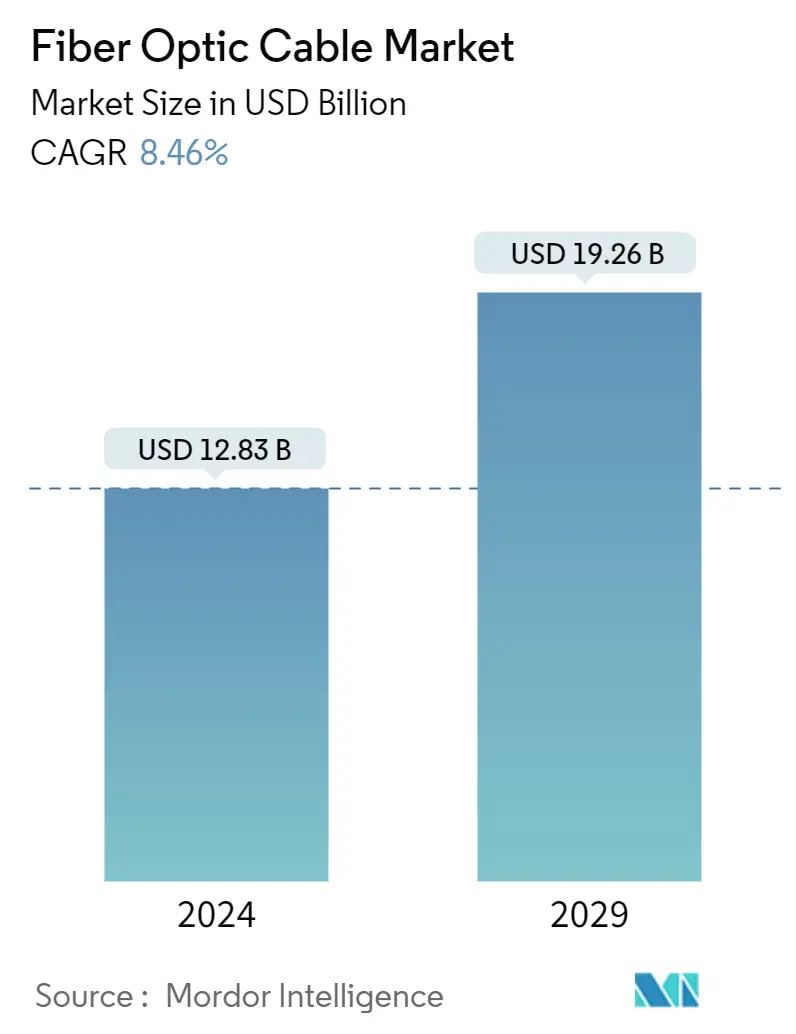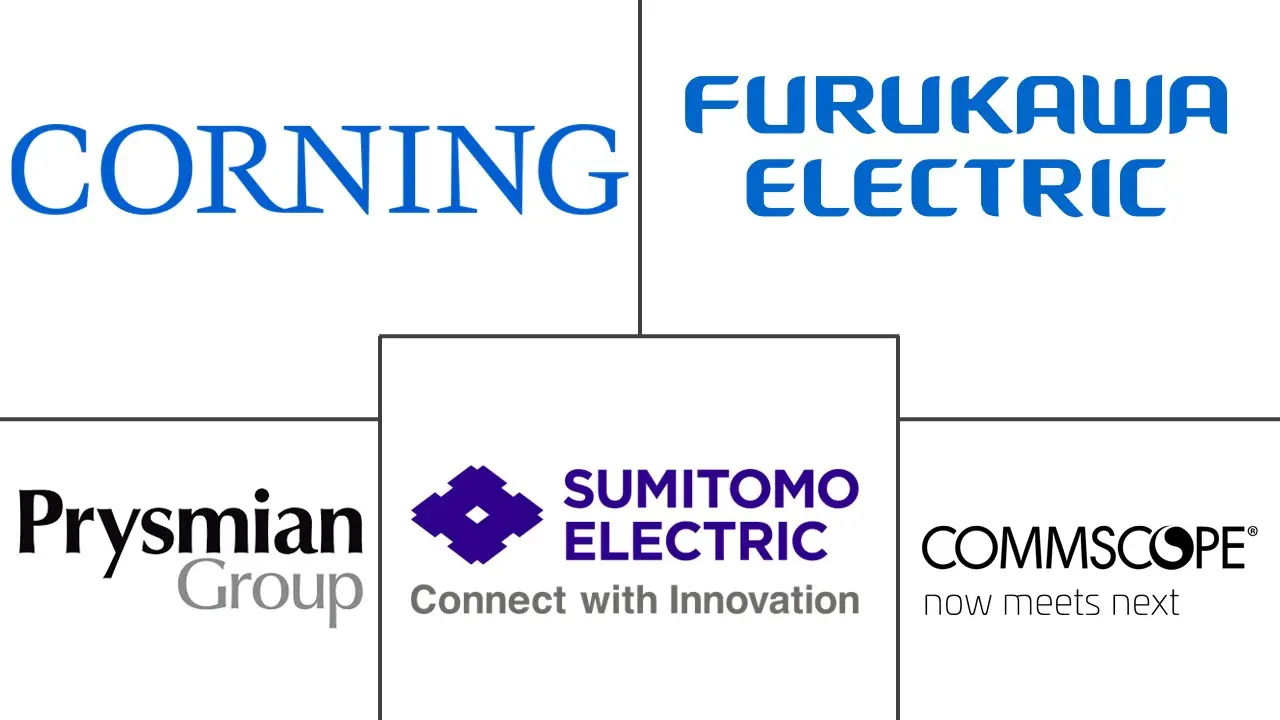Market Size of Fiber Optic Cable Industry

| Study Period | 2019-2029 |
| Market Size (2024) | USD 12.83 Billion |
| Market Size (2029) | USD 19.26 Billion |
| CAGR (2024 - 2029) | 8.46 % |
| Fastest Growing Market | North America |
| Largest Market | Asia Pacific |
Major Players
*Disclaimer: Major Players sorted in no particular order |
Need a report that reflects how COVID-19 has impacted this market and its growth?
Fiber Optics Cable Market Analysis
The Fiber Optic Cable Market size is estimated at USD 12.83 billion in 2024, and is expected to reach USD 19.26 billion by 2029, growing at a CAGR of 8.46% during the forecast period (2024-2029).
Increased broadband penetration, rising Internet TV streaming services, and the overall growth of the telecommunications sector are the main drivers. All these factors drive the increased use of fiber optic cables.
The evolution of fifth-generation networks and fiber optic infrastructure has driven digital transformation across industries. Optic fiber cable offers better security, reliability, bandwidth, and security than copper cables. Broadband penetration, increasing Internet TV streaming services, and the overall growth of the telecommunications industry have led to a substantial increase in FTTH. But there is also the newly emerging Internet of Things and working from home movement.
Furthermore, according to Ericsson, 5G subscriptions were expected to increase globally between 2022 and 2023, rising from over 0.55 billion to over 1.67 billion. Such a huge rise in 5G subscriptions was expected to drive the market.
The growing investments in fiber optic communication expansions with the growing connectivity globally are one of the major factors contributing to the market's growth. For instance, in October 2023, the Suez Canal Economic Zone signed an agreement worth USD 18 million in investments with the Chinese power and fiber optic cable manufacturer Hengtong to expand the latter's business in the TEDA-Egypt zone. Under the agreement, it sought to manufacture fiber optic cables with a capacity of up to two million kilometers in the region. The agreement will also contribute to fulfilling its contract obligations in connection with producing fiber optic cables, optical distribution networks, and ground telecommunications. This includes, but is not limited to, optical communications engineering, wire production and power engineering services, and the operation and maintenance of submarine fiber optic cables.
Although fiber optic cable offers many benefits, such as higher bandwidth, low latency, and a higher degree of reliability and flexibility, installing these devices may cost thousands of dollars. The growing demand for connectivity for optic fiber producers in developing nations presents significant business prospects. Yet factors such as installing fiber optic cables provide several operational difficulties for the market's growth.
The COVID-19 pandemic and lockdown affected capital investments and industrial activities globally. Following the global economic recession led by COVID-19, the market witnessed slow growth in 2020 and continued in 2021. All industries, including e-commerce, banking, retail, manufacturing, and healthcare, rapidly adopted digital technologies such as artificial intelligence, cloud, and analytics to stay competitive in the market, thereby experiencing significant growth in 2022 and 2023 with substantial expansions in the fiber optic network coverage contributing to the market's growth rate during the forecast period.
Fiber Optics Cable Industry Segmentation
Fiber optic technology utilizes highly flexible, transparent fiber of extruded glass or plastic to transmit data. Fiber optic cables incorporate glass threads as thin as human hair, transmitting messages modulated into light waves. Although these cables are made of glass, they are highly durable and malleable.
The fiber optic cable market is segmented by end-user industry (telecommunication, power utilities, defense/military, industrial, medical, and other end-user industries) and by geography (North America, Europe, Asia-Pacific [China, Japan, India, Malaysia, Indonesia, Thailand, Vietnam, Singapore, Philippines, and the rest of Asia-Pacific], Latin America, Middle East and Africa). The study tracks the key market parameters, underlying growth influencers, and major vendors operating in the industry, which supports the market estimations and growth rates during the forecast period. The study also tracks the revenue accrued from the various types used in various end-use industries globally. In addition, the study provides the global fiber optic cable market trends and key vendor profiles. The study further analyses the overall impact of COVID-19 on the ecosystem. The market sizes and forecasts are provided in terms of USD value for all the above segments.
| By End-user Industry | |
| Telecommunication | |
| Power Utilities | |
| Defense/Military | |
| Industrial | |
| Medical | |
| Other End-user Industries |
| By Geography | ||||||||||||
| North America | ||||||||||||
| Europe | ||||||||||||
| ||||||||||||
| Latin America | ||||||||||||
| Middle East and Africa |
Fiber Optic Cable Market Size Summary
The Fiber Optic Cable Market is anticipated to see considerable growth, driven by rising broadband penetration, increasing Internet TV streaming services, and the overall expansion of the telecommunications sector. The evolution of fifth-generation networks and fiber optic infrastructure has spurred digital transformation across various industries, making fiber optic cables a preferred choice due to their enhanced security, reliability, and bandwidth. Furthermore, the growing investments in fiber optic communication expansions globally are contributing significantly to the market's growth. However, the market also faces challenges such as high installation costs and operational difficulties associated with fiber optic cables. The impact of the COVID-19 pandemic also slowed growth in 2020 and 2021, but rapid adoption of digital technologies across industries has led to significant growth in 2022 and 2023. The Fiber Optic Cable Market is expected to continue growing, fueled by increasing demand from the telecommunications sector and the expansion of fiber optic networks.
Explore MoreFiber Optic Cable Market Size - Table of Contents
-
1. MARKET DYNAMICS
-
1.1 Market Drivers
-
1.1.1 Increasing Penetration of Internet and High Data Traffic
-
1.1.2 Increasing Adoption of 5G and FTTX
-
1.1.3 Rising Number of Data Center Facilities
-
-
1.2 Market Challenges
-
1.2.1 High Cost of Installation and Associated Complexities
-
-
1.3 Analysis of Pricing and Pricing Trends
-
1.4 Technology Roadmap
-
-
2. MARKET SEGMENTATION
-
2.1 By End-user Industry
-
2.1.1 Telecommunication
-
2.1.2 Power Utilities
-
2.1.3 Defense/Military
-
2.1.4 Industrial
-
2.1.5 Medical
-
2.1.6 Other End-user Industries
-
-
2.2 By Geography
-
2.2.1 North America
-
2.2.2 Europe
-
2.2.3 Asia-Pacific
-
2.2.3.1 China
-
2.2.3.2 Japan
-
2.2.3.3 India
-
2.2.3.4 Malaysia
-
2.2.3.5 Indonesia
-
2.2.3.6 Thailand
-
2.2.3.7 Vietnam
-
2.2.3.8 Singapore
-
2.2.3.9 Philippines
-
2.2.3.10 Rest of Asia-Pacific
-
-
2.2.4 Latin America
-
2.2.5 Middle East and Africa
-
-
Fiber Optic Cable Market Size FAQs
How big is the Fiber Optic Cable Market?
The Fiber Optic Cable Market size is expected to reach USD 12.83 billion in 2024 and grow at a CAGR of 8.46% to reach USD 19.26 billion by 2029.
What is the current Fiber Optic Cable Market size?
In 2024, the Fiber Optic Cable Market size is expected to reach USD 12.83 billion.
